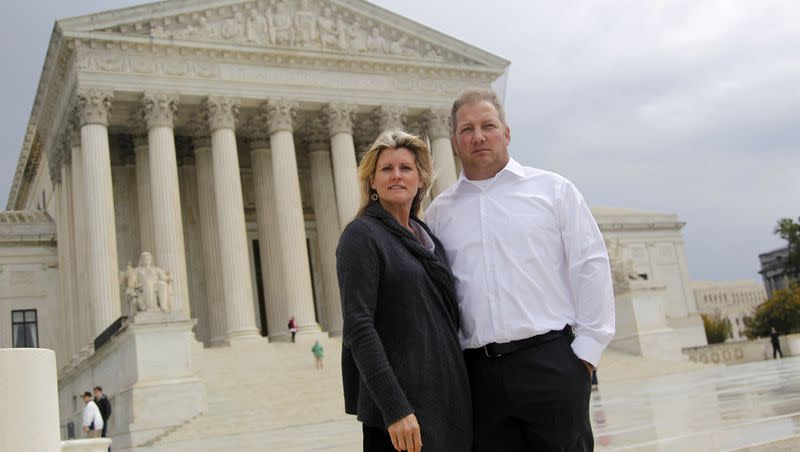Supreme Court: EPA water rule went too far, was too vague

In a victory for private property rights, landowners, farmers and ranchers, the U.S. Supreme Court unanimously struck down an Obama-era rule defining what constitutes a wetland or navigable waterway.
In a case brought by the Pacific Legal Foundation on behalf of an Idaho couple, Mike and Chantell Sackett, the foundation successfully argued that the rule was too broad and constituted regulatory overreach.
“The court’s ruling returns the scope of the Clean Water Act to its original and proper limits,” said Damien Schiff, a senior attorney at Pacific Legal Foundation who argued the case. “Courts now have a clear measuring stick for fairness and consistency by federal regulators. Today’s ruling is a profound win for property rights and the constitutional separation of powers.”
The Sacketts bought the land in Idaho with the intention of building their dream home, but were thwarted by a 2006 U.S. Supreme Court decision that critics said literally muddied the waters on the issue and resulted in the implementation of an EPA rule.
“The Sacketts’ vacant lot neighbors Priest Lake, which is 300 feet away and behind two rows of houses,” said Tony Francois, a former attorney with the foundation who was involved in the suit brought in 2008.
Francois said the U.S. Environmental Protection Agency and Army Corps of Engineers have construed a rule, called Waters of the United States, or WOTUS, to expansively extend their authority beyond what is reasonable due to the earlier Supreme Court decision that gave little to no clarity on the issue.
Related
What is a wetland?
The agencies insisted the residential lot was a wetland subject to federal authority and ordered their construction work stopped under threat of tens of thousands of dollars a day in fines unless they secured a federal permit. The Sacketts spent the next 16 years fighting for the right to use their property, according to the foundation. Their battle spanned four presidential administrations and every level of the federal court system, it added.
Related
The Clean Water Act turns 50. Here’s how it changed our lives
EPA administrator in Utah to get input on water rule, other regulations
A majority of the justices held to a plurality opinion in the 2006 case that the Clean Water Act applies to only those “wetlands” or water which must be relatively permanent and connected to traditional interstate navigable waters.
Justice Samuel Alito, who authored the opinion, warned that under the EPA’s interpretation of the Clean Water Act, “nearly all waters and wetlands are potentially susceptible to regulation under this (significant nexus) test, putting a staggering array of landowners at risk of criminal prosecution for such mundane activities as moving dirt.”
Utah was among an 11-state coalition that successfully got the rule put on hold with a federal injunction issued in 2018, and Utah’s state Legislature has weighed in with a resolution opposing the WOTUS rule.
President Joe Biden’s administration is now considering what next steps to take after a ruling that it said upends protections for critical wetlands and waterways.
“The court’s decision today aims to take our country backwards. It will jeopardize the sources of clean drinking water for farmers, businesses and millions of Americans,” White House press secretary Karine Jean-Pierre said, according to The Washington Post. “But know this, that President Biden will use every legal authority available to him to ensure Americans in every state have clean water.”
Jonathan Wood, vice president of law and policy at the Property and Environment Research Center, said he believes Thursday’s ruling will have a boomerang effect by bringing renewed emphasis on wetlands’ conservation.
“Today’s ruling brings significant clarity to federal wetlands regulation but also signals the need to ramp up voluntary wetland conservation. For decades, uncertainty over the extent of Clean Water Act regulation has made wetlands a liability for private landowners,” he said. “All nine justices rejected the prior vague standard in favor of relatively narrow understandings of federal authority over private property. Now that fewer wetlands will be regulatory liabilities for private landowners, it’s time for voluntary conservation efforts to make wetlands an asset to landowners.”
The good act and the bad act
In his opinion, Alito hailed the success of the Clean Water Act over the years.
“This case concerns a nagging question about the outer reaches of the Clean Water Act, the principal federal law regulating water pollution in the United States. By all accounts, the act has been a great success. Before its enactment in 1972, many of the nation’s rivers, lakes, and streams were severely polluted, and existing federal legislation had proved to be inadequate,” he wrote.
But Alito criticized the uncertainty embodied in the act.
“There is, however, an unfortunate footnote to this success story: the outer boundaries of the act’s geographical reach have been uncertain from the start. The act applies to “the waters of the United States,” but what does that phrase mean? Does the term encompass any backyard that is soggy enough for some minimum period of time? Does it reach ‘mudflats, sandflats, wetlands, sloughs, prairie potholes, wet meadows, (or) playa lakes?’ How about ditches, swimming pools, and puddles?”
Justice Brett Kavanaugh said while he agreed with the decision, he objected to the court’s new test of what waters are covered under the Clean Water Act.
“By narrowing the act’s coverage of wetlands to only adjoining wetlands, the court’s new test will leave some long-regulated adjacent wetlands no longer covered by the Clean Water Act, with significant repercussions for water quality and flood control throughout the United States.”
He went on to add: “The court’s erroneous test not only will create real-world consequences for the waters of the United States, but also is sufficiently novel and vague (at least as a single standalone test) that it may create regulatory uncertainty for the federal government, the states, and regulated parties.”

